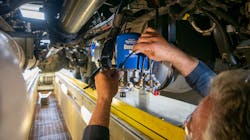While talk of electronic braking systems (EBS) is beginning to percolate through the North American trucking industry, conventional air brake systems (ABS) remain the overwhelming Class 8 truck spec—and will continue to be for some time. That said, technological changes are coming, according to experts.
“In general, the industry is advancing with air delivery and controls technology,” said John Crichton, director of field service at Navistar. “Component manufacturers continue to drive development of intelligent products for key components. We are seeing data elements or health information being transmitted electronically. The Bendix AD-HFi air dryer, for instance, not only improves serviceability access but incorporates electronics to provide adaptive purge cycles based on duty cycle. In the future, we expect components will increasingly become electronic and more intelligent, leading to fewer premature failures and better overall performance.”
The familiar and reliable air brake system isn’t going anywhere any time soon, added Chuck Brody, service team leader at ZF. He said new technologies such as electric trucks and regenerative brake systems, which capture kinetic energy created when a truck brakes and flow it back into the vehicle’s onboard batteries, are driving changes to air brake systems on which fleets soon will have to become educated.
“EBS are the standard in European trucking today,” Brody said. “They have logged millions of miles on European highways. So, it’s just a matter of time before that technology begins appearing in North America. Moreover, even cutting-edge electric trucks likely will have some form of air brake system for some time to come. Regenerative braking systems—that use regenerative deceleration first to slow the vehicle and capture kinetic energy, and then automatically switch to air systems to bring it to a complete stop—will be a good transition technology between the systems we have today in North America and full-blown, European-style EBS.”
Air systems expanding uses
Even more common technological advancements are changing air system technology now, noted Richard Nagel, director of marketing and customer solutions at Bendix Commercial Vehicle Systems. As automated manual transmission (AMT) adoption has steadily grown, compressed air isn’t just used for brake valves, he said. “Most AMT shifters are highly sophisticated devices and utilize the same air system,” Nagel explained. “As a result, the need for clean, oil-free air is increasingly important, along with dry air.”
A second significant change that’s coming, Nagel added, is the adoption of electronically controlled dryers on trucks. “That will be a big change in North America for drivers and techs,” he cautioned. “Additionally, there are a number of new air dryers being supplied on trucks today, and the old ‘standbys’ are being phased out. This new generation of air dryers is designed only for oil coalescing cartridges that can help provide high-quality air. Soon, we’ll start seeing the adoption of electronically controlled air dryers that use software to optimize the charging cycle, and that will be very different than what our industry has been familiar with.”
Tried-and-true maintenance practices for new challenges
When it comes to air system maintenance today, the good news is that even with all these potential changes looming just over the horizon, these are well-understood systems that are relatively easy to keep in good working order with a minimum amount of fuss.
Brody said he often tells fleet managers to engage more driver support in keeping tabs on air system health. “It’s really important to keep dust and debris out of the gladhands,” he said. “That is the easiest and most common way for contaminants to enter the system. Another good practice is to stress to drivers the importance of draining the air tanks on a truck every day. You also want to coach them on being alert to unusually large amounts of water draining from the system. And, of course, they need to be alert for air leaks when conducting both pre- and post-trip inspections.”
Fresh cartridges or filters should be a maintenance priority as they ensure clean air continues to flow to vital downstream brake controlling components as well as powertrain and suspension system components connected to air dryer pressure protection ports, according to Crichton. “Drivers should monitor air tanks and drain those tanks as needed,” he added. “When draining tanks, it’s best done after vehicle use rather than before, especially during the winter in colder climates. Below-freezing winter temperatures may cause standing water in the air system to freeze, as mentioned above. It is best if tanks are drained as part of the post-trip inspection."
"Additionally, components downstream from the air dryer may experience accelerated wear from contaminants bypassing regular or oil coalescing filters," Crichton continued. "Either condition may result in air leaks or system component failures in brake, powertrain, suspension, or any other device requiring air. Also be alert seals, O-rings, rubber, and plastics that may have been damaged by heat, moisture, or oil.”
Nagel warned that Bendix is seeing two consistent issues that are creating maintenance headaches for fleets these days. The first is compressors providing air—but also allowing oil aerosols to get into the air system. “This is leading to more issues tied to excessive oil passing and elevated discharge line temperatures,” he warned.
The next new problem is corrosion, which he said is a product of more swings in weather patterns. “These are causing more freeze-and-thaw cycles along with more aggressive road treatments to prevent road freezing,” Nagel explained. “As a result, we’re seeing more issues with oxidation of aluminum housings, problems with electrical wiring, and so on.”
To combat these issues and others, Nagel noted that Bendix has recommended quarterly inspections of air drained from the service tanks for many years—perhaps more often if the truck consumes a lot of air. “That’s still good advice,” he added. “A lot of our fleets replace common service items like purge valves and cartridges at the same time—typically, every two years.”
About the Author
James Alfred
James Alfred is a freelance journalist with more than 15 years of experience in the trucking industry.
